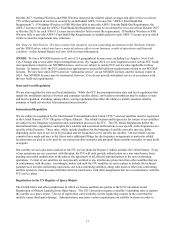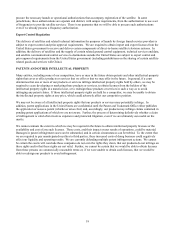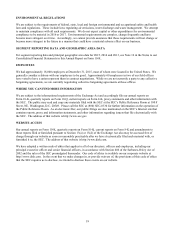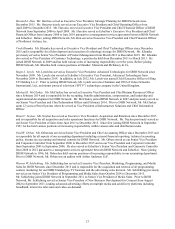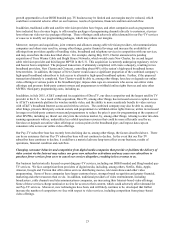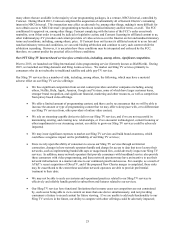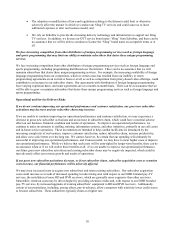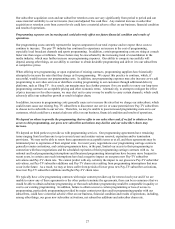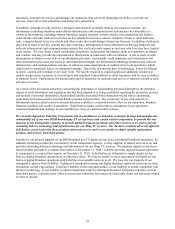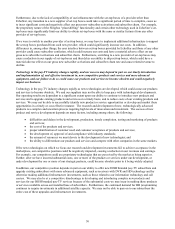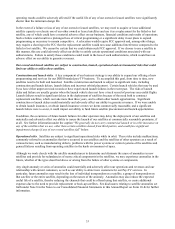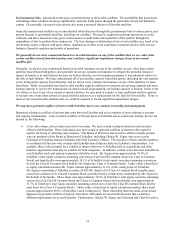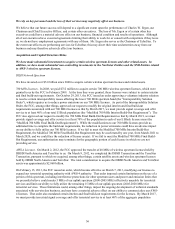Dish Network 2015 Annual Report Download - page 37
Download and view the complete annual report
Please find page 37 of the 2015 Dish Network annual report below. You can navigate through the pages in the report by either clicking on the pages listed below, or by using the keyword search tool below to find specific information within the annual report.27
Our subscriber acquisition costs and our subscriber retention costs can vary significantly from period to period and can
cause material variability to our net income (loss) and adjusted free cash flow. Any material increase in subscriber
acquisition or retention costs from current levels could have a material adverse effect on our business, financial condition
and results of operations.
Programming expenses are increasing and could adversely affect our future financial condition and results of
operations.
Our programming costs currently represent the largest component of our total expense and we expect these costs to
continue to increase. The pay-TV industry has continued to experience an increase in the cost of programming,
especially local broadcast channels and sports programming. In addition, certain programming costs are rising at a much
faster rate than wages or inflation. These factors may be exacerbated by the increasing trend of consolidation in the
media industry, which may further increase our programming expenses. Our ability to compete successfully will
depend, among other things, on our ability to continue to obtain desirable programming and deliver it to our subscribers
at competitive prices.
When offering new programming, or upon expiration of existing contracts, programming suppliers have historically
attempted to increase the rates that they charge us for programming. We expect this practice to continue, which, if
successful, would increase our programming costs. In addition, our programming expenses may also increase as we add
programming to our video services or distribute existing programming to our customers through additional delivery
platforms, such as Sling TV. As a result, our margins may face further pressure if we are unable to renew our long-term
programming contracts on acceptable pricing and other economic terms. Alternatively, to attempt to mitigate the effect
of price increases or for other reasons, we may elect not to carry or may be unable to carry certain channels, which could
adversely affect our subscriber growth or result in higher churn.
In addition, increases in programming costs generally cause us to increase the rates that we charge our subscribers, which
could in turn cause our existing Pay-TV subscribers to disconnect our service or cause potential new Pay-TV subscribers
to choose not to subscribe to our service. Therefore, we may be unable to pass increased programming costs on to our
customers, which could have a material adverse effect on our business, financial condition and results of operations.
We depend on others to provide the programming that we offer to our subscribers and, if we fail to obtain or lose
access to this programming, our gross new subscriber activations may decline and our subscriber churn may
increase.
We depend on third parties to provide us with programming services. Our programming agreements have remaining
terms ranging from less than one to up to several years and contain various renewal, expiration and/or termination
provisions. We may not be able to renew these agreements on acceptable terms or at all, and these agreements may be
terminated prior to expiration of their original term. In recent years, negotiations over programming carriage contracts
generally remain contentious, and certain programmers have, in the past, limited our access to their programming in
connection with those negotiations and the scheduled expiration of their programming carriage contracts with us. As
national and local programming interruptions and threatened programming interruptions have become more frequent in
recent years, in certain cases such interruptions have had a negative impact on our gross new Pay-TV subscriber
activations and Pay-TV churn rate. We cannot predict with any certainty the impact to our gross new Pay-TV subscriber
activations, net Pay-TV subscriber additions and Pay-TV churn rate resulting from programming interruptions that may
occur in the future. As a result, we may at times suffer from periods of lower gross new Pay-TV subscriber activations,
lower net Pay-TV subscriber additions and higher Pay-TV churn rates.
We typically have a few programming contracts with major content providers up for renewal each year and if we are
unable to renew any of these agreements or the other parties terminate the agreements, there can be no assurance that we
would be able to obtain substitute programming, or that such substitute programming would be comparable in quality or
cost to our existing programming. In addition, failure to obtain access to certain programming or loss of access to
programming, particularly programming provided by major content providers and/or programming popular with our
subscribers, could have a material adverse effect on our business, financial condition and results of operations, including,
among other things, our gross new subscriber activations, net subscriber additions and subscriber churn rate.


